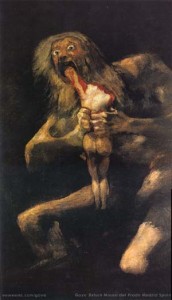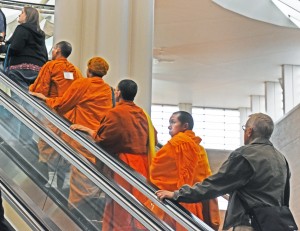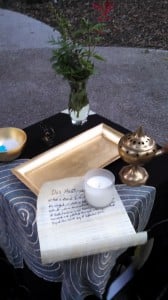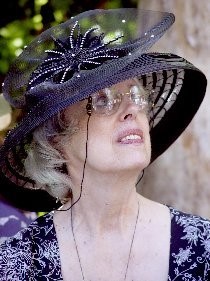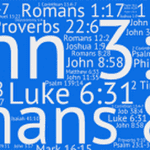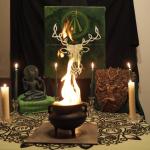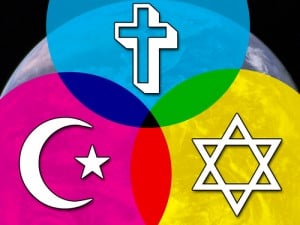
via Shutterstock
A lot of interfaith events are structured like the image to the right. Their goal is to find points of intersection, i.e. common ground, between the world’s largest monotheistic faiths. Let me be clear: such an event is 100% interfaith and the world would stand to benefit from more dialog between Christianity, Judaism, and Islam.
Here’s a question, though: what are the top five world religious in terms of population?
If your guess was (essentially) Christianity, Judaism, and Islam plus any two other faith groups, you’d be wrong. According to the Global Religious Landscape by the Pew Research Center, here’s the correct answer based on data from 2010:
- Christianity (31.5%)
- Islam (23.2%)
- Unaffiliated (16.3%)
- Hinduism (15.0%)
- Buddhism (7.1%)
Crazy, right? Judaism doesn’t even make the top five!? As a Jew (ethnically) and an American, I remember finding that very shocking the first time I learned it. And, to be honest, things are a little different here in the United States. Our top five are as follows: Christianity, Unaffiliated, Judaism, Buddhism, and Islam. As a result, perhaps it’s not quite as surprising that out interfaith events are dominated by the aforementioned monotheism. But, while I’ve met a number of very engaged atheists — especially when I had closer ties to the Interfaith Youth Core — at interfaith events, I’ve only ever attended one event at which there was a Buddhist. Even my local interfaith council appears to be made up of representatives from local Christian churches and a single Rabbi despite a sprawling Buddhist temple in the local area. Unfortunately, that group’s website hasn’t been updated since 2010 despite their involvement in a few events over the last year, so I can’t be fully sure of its membership. That said, at a recent prayer event, only about a dozen Christians and a Rabbi were present as celebrants.
Again, I feel the need to state clearly: just because the only members of an interfaith event — be it a dialog, prayer event, activist meet-up, etc. — are all monotheists doesn’t make it any less valuable. For that matter, you could have an interfaith event made up only of Jews, for example; the Orthodox, Conservative, and Reform movements are similar enough to group together but different enough that they’d have a lot to talk about. Then, consider the history between Protestants and Catholics or Sunni and Shi’a Muslims and it’s pretty clear that conversations that are happening under a specific religious umbrella are still between different religious traditions.
But, there’s something special that happens when there’s someone that doesn’t quite fit into the expected religious milieu of the area. My experience is only here in the United States where almost 80% of our population is Christian and 16% is unaffiliated. Everyone else has to be crammed into the remaining 4 to 6% of the population, and that can make it hard to find our part in the religious (and non-religious) chorus. As a result, some of my favorite interfaith experiences are those moments when simply by being different from what people expect, I’ve been able to shake up a conversation and enable some real teachable moments.
Plus, these sorts of meetings help drastically reduce hostility between groups. There’s a concept in psychology called the contact hypothesis. Essentially, it holds that meeting people who are different from you reduces your ability to stereotype that other group and, therefore, reduces prejudice and discrimination. This theory has proven to be especially successful in building bridges between hetero- and homosexuals and has helped reduced prejudice toward Muslim populations in Europe. To put it more bluntly: diversity is good and helps make the world a better place.
By and large, I don’t think that American Pagans suffer a great deal of injustice; the average American may not even know that we exist! But, there remains a stigma surrounding the terminology we use to describe ourselves (e.g. witch, pagan, heathen, etc.) and misunderstandings about our practices in parts of the country that keep more than a few of us in the broom closet. Those of us who are able to step out of it and into an interfaith community will, hopefully, be helping us all simply by being meeting others, shaking hands, and sharing a bit about our practices with them.
That does, however, leave us with a bit of a conundrum: we can’t possibly speak universally about such a diverse population and yet, because of our difference from the status quo, we’re nevertheless somewhat expected to do so. This is especially the case when our dialog partners are often left with only one point of contact with the Pagan community; i.e. people like me. And, I wonder what that selection bias does to the image that we present to others in an interfaith setting.
Over my next few posts, I’m going to explore some of these ideas. Next time, I’m going to explore the sense that being different actually gives us a certain amount of power in an interfaith setting. We’re not what others are expecting, and we can use their surprise to create teachable moments not only to help educate them about our faith practices, but also to enhance the interfaith events that they create in the future. Then, I’ll be discussing the two different prejudices that I’ve encountered most regularly while attending interfaith events with respect to Paganism in general and what I’ve done to try and help undo those assumptions. Finally, I’ll do my best to explore exactly how I deal with the unquenchable curiosity that I’ve encountered from dialog partners and how their expectations, colored as they are by their largely monotheistic understanding of religion, often need to be deconstructed.
Before I leave you all today, I also wanted to mention that I’ll be attending the Parliament of World Religions this October in Salt Lake City, UT. If you’re also attending, I’d be very interested in meeting up with anyone who’s a reader of the blog. Feel free to get in touch with me in the way that seems best to you.






